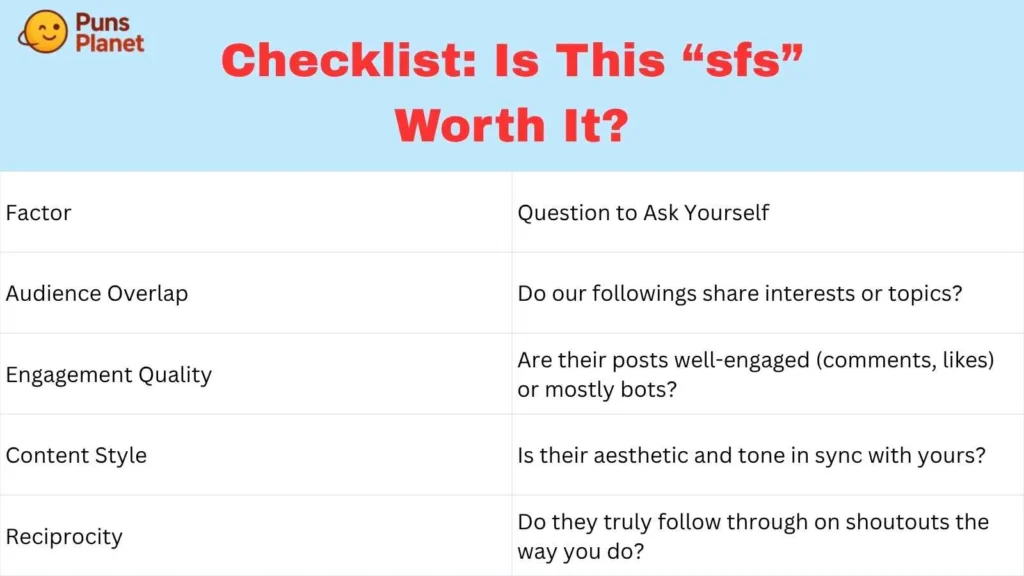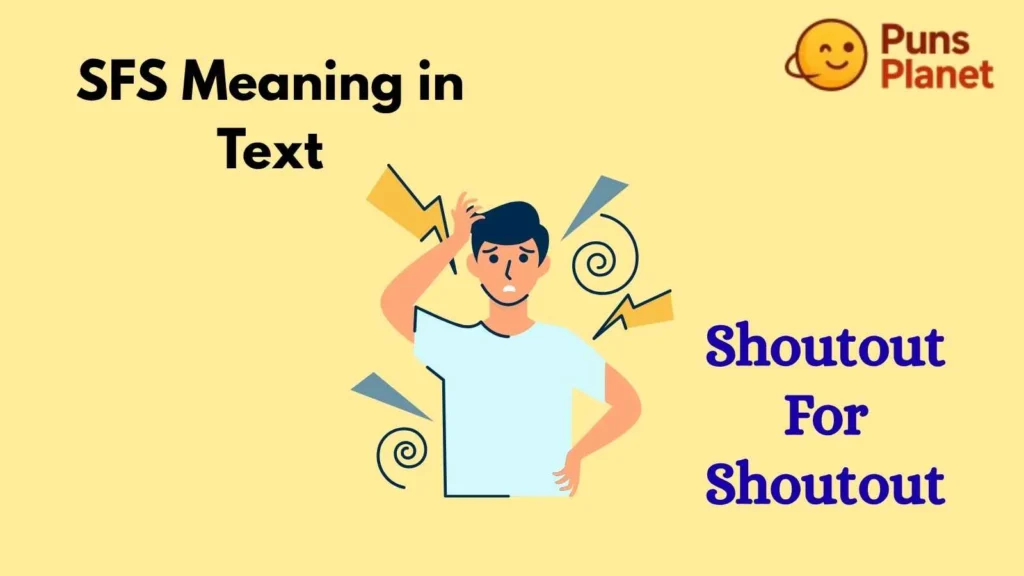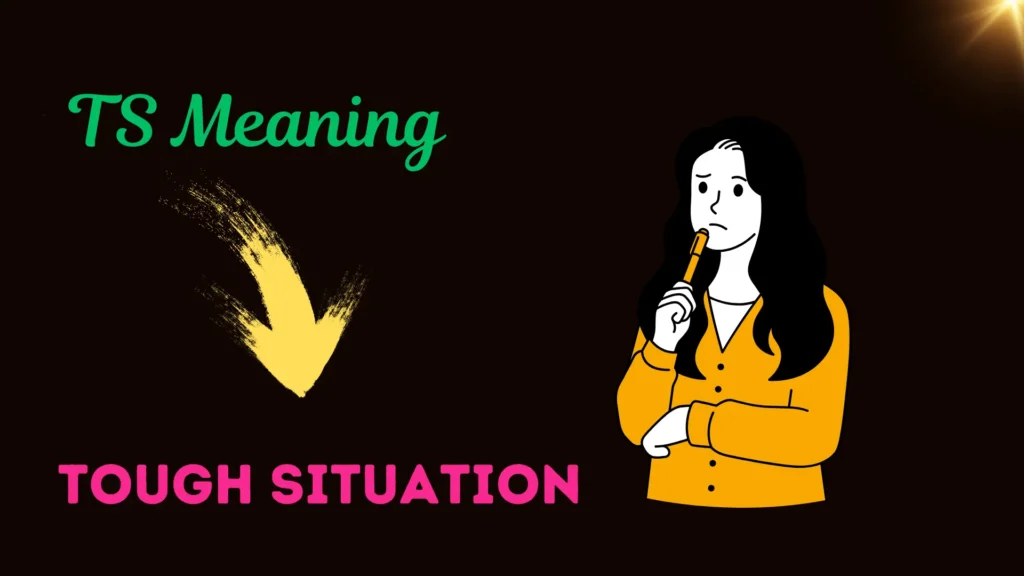Have you ever seen someone type sfs in a text, comment, or story and wondered, what does that even mean? You’re not alone.
In this guide, we’ll unpack the sfs meaning in text, explore its origins, show you how to use it (and when *not* to), and share real-life examples that’ll help you speak modern digital fluently.
What Does “sfs” Mean?
The acronym sfs stands for “Shoutout For Shoutout.” It’s commonly used on social media platforms like Instagram, TikTok, Snapchat, and Twitter to propose mutual promotion between users.
In other words, when someone types sfs, they’re asking another user to give them a shoutout—and in return, they will do the same. It’s a collaborative strategy to expand reach and followers quickly.
Origin & Why It’s Popular

- Community Growth: In the era of micro-influencers and personal branding, shoutouts help cross-promote accounts.
- Mutual Benefit: Both parties gain exposure; it’s a win-win.
- Low Effort: Versus paid promotions, you only need to mention the other person in your post or story.
Primary vs. Secondary Meanings
While the most common meaning of sfs is “Shoutout For Shoutout,” a few users or communities may interpret it differently depending on context:
- “Snap For Snap”: Less commonly, “sfs” can mean exchanging Snapchat usernames or snaps.
- “Save For Save”: Rarely—but in some communities, “sfs” may imply saving someone’s post in exchange for theirs.
However, trust the usual meaning: **Shoutout For Shoutout**—especially in comment-based exchanges on Instagram or TikTok.
How to Use “sfs” in Text & Social Media
Here are some examples showing proper use. Always match it to your platform style.
- Instagram Story Ask: “Sfs anyone? 👀”
- Comment Under a Similar Account: “sfs? love your vibe!”
- DM Request: “Hey! Want to sfs? I’ll feature you tomorrow.”
- TikTok Caption: “sfs with creators—drop your link 🔗”
Example Conversation
User A: “sfs?”
User B: “Sure! Share yours and I’ll post.”
Why People Use “sfs”? 🚀
Here’s why “sfs” is such a huge trend:
- Gain Followers Quickly: You reach a new audience through someone else’s followers.
- Build Relationships: It’s a friendly collaboration rather than transaction.
- Free Marketing: There’s no cost involved, just mutual support.
- Boost Visibility: Especially useful for accounts in the early stage of growth.
When “sfs” Might Not Be Appropriate
Even though “sfs” is handy, there are moments you should think twice before using it:
- If you already have a large following and the shoutout may dilute your brand.
- When someone’s account doesn’t align with your style, ethics, or niche.
- In formal or professional communications—these are usually reserved for friends, influencers, or casual creators.
- When you suspect spam or low-quality content behind an “sfs” ask.
How to Ask for an “sfs” Professionally
Want to use “sfs” but still look polished? Here are some smart tips:
- Use a friendly greeting: “Hey [Name], hope you’re well!”
- Explain the benefit: “Would you like to do an sfs? I think your followers would love my style.”
- Offer proof: Share an example of past shoutouts (e.g. “My last sfs brought +200 likes”).
- Follow up with gratitude: “Thanks for collaborating 💛”
Alternatives to “sfs” (Other Engagement Tactics)
If you’re looking for more variety, consider these engagement ideas:
- Collab Fridays: Post joint content with another creator.
- Guest Takeovers: Let someone post on your account (or vice versa).
- Mutual Likes & Comments: Agree to like/comment on each other’s newest posts.
- Feature Exchanges: Highlight someone in your caption or video—and they do the same for you.
Spotting Fake or Low-Value “sfs” Requests
Not all sfs offers are equal. Watch out for:
- Accounts with no genuine posts or low engagement (potential spam).
- Profiles that don’t resonate with your brand or niche.
- Messy DM patterns—lots of sfs requests without follow-through.
- Uneven value: If your shoutout produces little gain while theirs drives huge exposure without reciprocity.
Checklist: Is This “sfs” Worth It?

| Factor | Question to Ask Yourself |
|---|---|
| Audience Overlap | Do our followings share interests or topics? |
| Engagement Quality | Are their posts well-engaged (comments, likes) or mostly bots? |
| Content Style | Is their aesthetic and tone in sync with yours? |
| Reciprocity | Do they truly follow through on shoutouts the way you do? |
Common Mistakes with “sfs” and How to Avoid Them
Here are pitfalls many users face when using “sfs” — and how you can sidestep them:
- Always Posting Without Follow-Through: Make sure you complete your side of the shoutout.
- Asking Random Accounts: Only request from people who align with your brand or values.
- Ignoring Performance Metrics: Don’t assume more shoutouts = more growth. Track your gains.
- Using “sfs” Too Frequently: It can look spammy and hurt credibility.
“sfs” Across Platforms: Does It Change?

While “sfs” is broadly used, its form or etiquette can vary by platform:
Most common on stories or comments. Users tag others and write “sfs?” to ask for a shoutout.
TikTok
Used in video captions or comments to initiate shoutout collaborations among creators.
Snapchat
Less common, but when used it often pairs with “for Snap” or “swap names.” Double-check context.
Twitter / X
Can show in replies or tweets, but often spelled out (“Shoutout for Shoutout”) rather than using shorthand.
Does Using “sfs” Actually Help Growth?
Yes—with caveats. When done right, “sfs” can generate increased followers, improved engagement rates, and genuine community building. But results depend on:
- Quality of the collaborating account
- Frequency and timing of shoutouts
- How well you maintain content consistency after gaining new visibility
By analyzing your metrics (likes, comments, click-throughs), you can assess whether “sfs” is working for your goals or not.
Best Practices: Making “sfs” Work for You
Follow these expert tips to get the most value from your sfs strategy:
- Be Selective: Choose partners whose audience genuinely overlaps.
- Track Everything: Use platform analytics to see follower spike or referral traffic after shoutout.
- Space Out Requests: One or two high-quality sfs per week is better than mass asking.
- Balance Content: Mix sfs stories with original content so your account feels authentic.
FAQs:
1. Can “sfs” hurt my account?
Not usually—if used sparingly and with care. But if you’re engaging with spammy or irrelevant accounts, or doing sfs too often, it could reduce trust from your real followers.
2. Is “sfs” just for influencers?
No. Anyone can use it. Whether you’re building a hobby page, a small business account, or personal brand, sfs can help if used strategically.
3. How often should I ask for “sfs”?
Aim for 1–2 quality sfs requests per week. Too many may seem pushy or insincere.
4. Should I offer something in return beyond a shoutout?
Depends on your niche. Sometimes tagging back, doing a story collaboration, or co-creating content works better than just sfs.
5. How can I track the impact of an “sfs” shoutout?
Use analytics tools built into social media platforms. Monitor follower growth, story/impression metrics, and engagement rate before & after shoutout.
Conclusion:
The term sfs may seem simple—just three letters—but its impact on social media growth can be significant when used wisely.
It’s a powerful tool in your engagement arsenal, especially if you’re building a community, brand, or personal voice online.
By choosing the right partners, following best practices, and tracking your results, you can make “sfs” work in your favor without losing authenticity.







